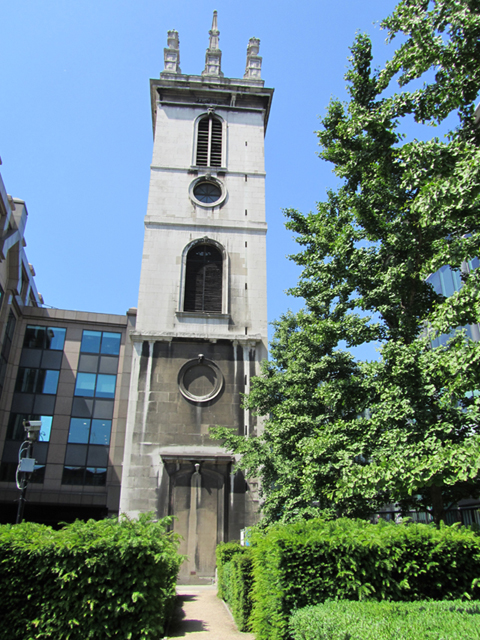Tower of St Mary Somerset Church (City of London)
Brief Description
St Mary Somerset dates from at least the C12th, and appears to have been called St Mary's Summer's Hith, perhaps due to its proximity to a wharf or 'hith' owned by a family of that name or after Ralph de Sumery. Destroyed in the Great Fire of 1666 the church was rebuilt by Wren in 1685-94. Churchwardens' Accounts for 1680 record that 6 elm trees were planted in the burial ground. The church was demolished in 1869 and the site was acquired by the Corporation of London in 1872. The tower at the south-west corner was saved by an Act of Parliament and is all that remains of the church, standing within a small garden formed on the former burial ground. On the level area facing the tower the garden is largely planted with yew and privet hedging, creating seating areas protected from the busy road alongside. Behind the tower the garden slopes steeply upwards.
Practical Information
- Site location:
- Upper Thames Street/Castle Baynard Street/Lambeth Hill
- Postcode:
- EC4V 4GG
- What 3 Words:
- soap.desire.frame
- Type of site:
- Public Gardens
- Borough:
- City of London
- Open to public?
- Yes
- Opening times:
- unrestricted
- Special conditions:
- Facilities:
- Events:
- Public transport:
- Tube: Mansion House (District, Circle)
- Research updated:
- 01/06/2010
- Last minor changes:
- 19/07/2023
Please check with the site owner or manager for latest news. www.cityoflondon.gov.uk/openspaces
Full Site Description
An engraving from a drawing by Frederick Mackenzie in Godwin (1838) shows the churchyard of St Mary Somerset with gravestones. Churchwardens' Accounts for 1680 record that 6 elm trees were planted in the burial ground. The foundation of St Mary Somerset dates from at least the C12th, and Sir John de Peyton is documented as presenting to the church in 1335. It appears to have been called St Mary's Summer's Hith, perhaps due to its proximity to a wharf or 'hith' owned by a family of that name or perhaps after someone called Ralph de Sumery. According to John Stow, in 1370 the churchyard was used as the place where weavers of Brabant were to gather for the purposes of hiring, whereas Flemish weavers were to gather for the same purpose in the churchyard of St Lawrence Pountney (q.v.). The reason for this separation was due to disputes among the weavers. St Mary Somerset, which stood at the corner of Old Fish Street Hill and Thames Street, was destroyed in the Great Fire of 1666 and rebuilt by Wren in 1685-94 at which time it united with the parish of St Mary de Monte Alto or Monthaut on Old Fish Street Hill, which was also destroyed in the fire but not rebuilt. This church had belonged to the Bishop of Hereford and was built pre-1275 as the Mounthaunt family chapel, hence the name, and its site was used as a burial ground until Queen Victoria Street was built over it. In 1701 Gilbert Hereford, Bishop of Hereford, was buried here, a memorial tablet set in the pavement in the chancel.
The church was demolished in 1869 and the site acquired by the Corporation of London in September 1872; the altar, font, pulpit and bell went to St Mary Hoxton. The square stone tower, which stood at the south-west corner of the building, independent of the body of the church, was saved by an Act of Parliament and is all that remains standing within a small garden, which slopes steeply upwards. The tower has an elaborate cornice with a square pedestal at each corner each surmounted by an urn, between which are further pedestals each with an ornamental obelisk, restored in 1956 by Corporation of London. The sloping garden area was chiefly in the form of a flight of steps leading towards Queen Victoria Street with raised beds either side planted with trees and shrubs. In the early C21st it was closed due to sewerage works apart from a strip of grass with some flowers at the junction of Upper Thames Street and Castle Baynard Street to the east of the tower. One of the trees was damaged during these works. The re-landscaped garden is now open, and largely consists of blocks of shaped hedging, with trees and benches set within it.
Sources consulted:
George Godwin & John Britton 'The Churches of London: A history and description of the Ecclesiastical Edifices of the Metropolis, Volume II', London, 1839; Simon Bradley & Nikolaus Pevsner, 'The Buildings of England, London 1: The City of London', 1997 (1999 ed.); London Diocesan Advisory Committee for the Care of Churches data; Gerald Cobb 'The Old Churches of London', Batsford, 1942.
Further Information (Planning and Conservation)
- Grid ref:
- TQ321808 (532160,180880)
- Size in hectares:
- 0.0166
- Site ownership:
- Diocese of London (former churchyard)/City of London Corporation
- Site management:
- City of London Corporation Open Spaces Dept.
- Date(s):
- C12th onwards
- Designer(s):
- Listed structures:
- LBI: Tower of former church of St Mary Somerset
- On National Heritage List for England (NHLE), Parks & Gardens:
No- Registered common or village green on Commons Registration Act 1965:
No- Protected under London Squares Preservation Act 1931:
No
Local Authority Data
The information below is taken from the relevant Local Authority's planning legislation, which was correct at the time of research but may have been amended in the interim. Please check with the Local Authority for latest planning information.
- On Local List:
- No
- In Conservation Area:
- No
- Tree Preservation Order:
- No
- Nature Conservation Area:
- No
- Green Belt:
- No
- Metropolitan Open Land:
- No
- Special Policy Area:
- Yes - Thames Policy Area/St Paul's Heights Policy Area
- Other LA designation:
- Strategic Viewing Corridor
Photos
Tower of St Mary Somerset Church, June 2010. Photo: S Williams
Click a photo to enlarge.
Please note the Inventory and its content are provided for your general information only and are subject to change. It is your responsibility to check the accuracy.







